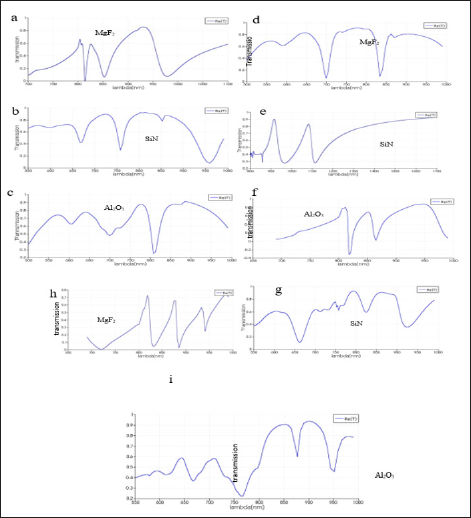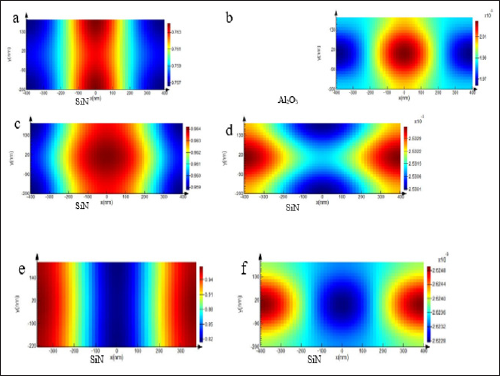Impact Factor : 0.548
- NLM ID: 101723284
- OCoLC: 999826537
- LCCN: 2017202541
Mohanad Hasan Ali Aljanabi*
Received: October 01, 2018; Published: October 10, 2018
*Corresponding author: Mohanad Hasan Ali Aljanabi, Department of Electrical Power Techniques Engineering, Al-Furat Al-Awsat Technical University, Iraq
DOI: 10.26717/BJSTR.2018.09.001869
The optical properties of surface plasmons at the resonant wavelength depend on the geometrical nanostructure of materials, refractive indices, thickness [materials and dielectrics], and shapes of the formation unit cell nanoantennas. In this study, we take different shapes of plasmonic nanoantenna structures with a prototype of single and dual U- shapes as a common part to format a unit cell of nanoantenna by adding T and L-shapes based on a different dielectric such as, a silicon nitride, magnesium fluoride, and aluminium oxide, with gold as a variation of refractive indices. A single U-shape provides a dual spectral resonance at a wavelength range of [500-950] nm. Thus, in these proposed structures, we try to achieve a triple band with the best transmission and field enhancement distributions (electric field intensity and magnetic field intensity), and we design and simulate these fractals by using the 3D- finite difference time domain method Lumerical program with an incident source between a visible to infrared range. From the results, the triple bands have a wide range of applications in medicine as biosensors and in communication systems foptical modulators].
Nanoantenna is a nanoparticle of metallic structures designed to deal with light [1,2]. The principles of working such a device is to improve the energy conversion between the nanoantennas and free radiation field [3].The operation of the nanoantenna takes place successfully in a range between IR to visible, so it has great development designs [4]. A surface Plasmons [SPs] of metallic that is excited by an incident of light has extraordinary effects that have recently become a study focus [5-7]. Currently nanoantennas are being designed in different shapes and material arrangements [8,9]. The properties of dielectrics have strong effects on LSP [Localized Surface Plasmons], which is important for sensing applications such as optics, biology, and material sciences [10,11] because they depend on localized practical resonances. Thus, it is easy to perform the measurements of [optical parameters] such as absorption, reflection, scattering, and transmission [12-15]. Over the last few years, different shapes of nanoantenna have been proposed by changing arrangement of the parts to obtain multi resonances in a range of mid IR [16] and improve the reflection for spectrometry [17], such as Bowtie [18], loop [19], and triangular [20] as a basic design. On the other hand, there are complicated structures such as the U-shape [21], and SRR [split ring resonator] [22-24]. Several models of nanoantennas plasmonic shave have been designed and fabricated by Altug et al that deposit Au and Ti on SiN membrane layers [25], while Mosallaei used silver [Ag] based on Silicon substrate [26]. Also, the U-shape is used with other structures such as the Jerusalem Cross [JC] to present multi resonances as perfect metamaterial absorbers [MA] in the THz region [27]. Zarrabi added the U- shape to the H-shape in order to achieve a triple resonance by using the CST program [28]. The arrays of the U-shaped metallic periodic with SRRs to improve the magnetic resonances of metamaterials are composed of high-quality sensing [29].
In this article, we take a different shape of plasmonic nanoantenna structure with a prototype of a single and dual U- shape as a common part to format a unit cell of nanoantenna by adding T and L-shapes of the gold base on a different dielectric such as , SiN,(n=1.98,2,2.16), MgF2, (n = 1.37,1.36) and Al2O3, [n = 1.76] as a variation of the refractive indices. Consequently, in these proposed structures, we attempt to achieve a triple spectral with the best transmission and field enhancement distributions (electric field intensity (E) and magnetic field intensity (H)), we design and simulate these fractals by using the 3D- FDTD method Lumerical program with an incident source between the visible -IR range.
In this study, Figure 1 shows the different shapes ofthe Symmetric unit cell of the nanoantenna with geometrical parameters (L, H, W, t) representing the length, height, width, and thickness of the metal respectively, including S the distance between the two shapes in the same unit cell. The shapes of the nano structures basically depend on the deposition of a gold (Au) layer with (t=100nm) on a substrate, which is variable like SiN,(n= 1.98,2,2.16), MgF2,(n= 1.37,1.36)and Al2O3, (n = 1.76), with the dimensions of the unit cell; L=800nm,H=400nm and W=(75- 100)nm. Three models of the nano antennas are proposed by using the U-shape added to L, T shapes in a 3D FDTD Lumerical program to design a simulation Plasmonic nanoantenna trying to achieve dual and triple spectral resonance and field enhancement distributions E and H with the best transmission, therefore, we used a multi type of substrate model in order to change the refractive index that effects the surface Plasmon resonance with each a model.
Figure 1: Schematic view of single and dual U-shapes of nanoantenna structures in different designs: a) single U with dual L shapes. b) Dual U with 4 L shapes. c) Dual U with dual T shapes.

We found the values of wave number (ksp) with different values of refractive index and Surface Plasmon frequency («_sp) from equations (1,2) [30].

ForDrudemodelsofmetal, suchasAuorAg,thedielectricconstant sm can be written as a function of frequency («) from equation (3).

Where sm, r and sm, i are real and imaginary parts of the metal's dielectric constant, respectively, sb is the static term due to the bound charge, and γ is the damping coefficient [31].
Figure 2 shows the results of the simulation of three models (dual U, dual T, a single U Dual L, and dual U 4L) with different refractive indices; this work is performed by 3D -FDTD, by a Lumerical solution Inc. The periodic boundary conditions were considered for the x- and y-directions, respectively, and PML boundary condition for z -directions at an incident of an electromagnetic wave in the z-direction. From Table 1 these models are operated in visible to IR regime and high transmission achieved with the dual U, 4L with Al2O3 (n=1.76) approximate to 0.94 in near IR, also we obtain high transmission in a visible range with Al2O3 and SiN (n=2.16) special in a single U and dual L. On the other hand, we can see that there are triple resonances in both designs (Dual U, dual T and Dual U, 4L) with MgF2 (n=1.36) in the same range. In Figure 3 the field enhancement distributions of E appear strongly with the SiN substrate for all the models in a single U, and a dual L approximate to 0.96 at the centre of structure. While the field enhancement distributions of H noticed in the dual U, 4L about 2.62E-3concentrated on both sides of the structure. On the other hand, with Al2O3; H is concentrated at the centre with a value 2.01E-3.
Figure 2: Shows the transmission spectrum Vs wavelength with different refractive indices for the proposed models of plasmonic nano antennas: a, b and c for dual U, dual T. d, e and f for single U, dual L. g, h and i dual U,4L.

Figure 3: best field distributions of E and H; a and b represent E, H for dual U, dual T. c and d represent E, H for single U, dual L. e and f represent E, H for dual U, 4L.

As a result of the interaction between the incidents light with the surface of the metals, each model demonstrates that dielectric and refractive index and also the thickness of the substrate have an effect on radiation efficiency. High transmission and field enhancements show a distribution that is related to the effect of the positions of the surface plasmons which reveals them to be a good candidate for biosensor applications. These models offer flexibility and a wide range of designing and fabrication structures and optimizing the response of surface Plasmon at visible and near the IR regime. The proposed different shape of models of nanoantenna plasmonic can also support dual and triple response resonances of operations and act as a high transmitted for new devices. Through these results, we can find some methods for new arrangements to enhance plasmonic nanoantennas quality and accuracy.


